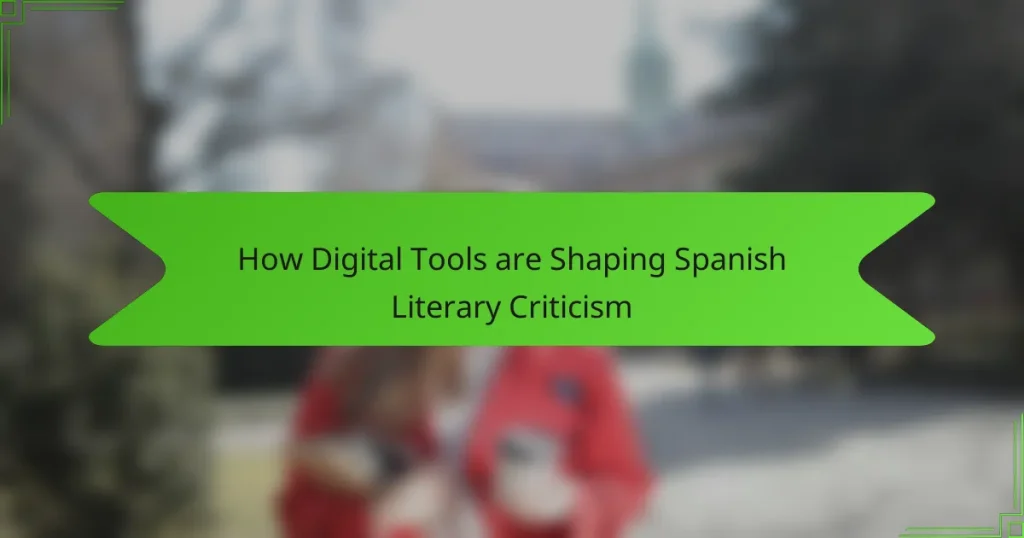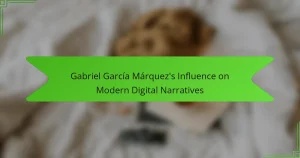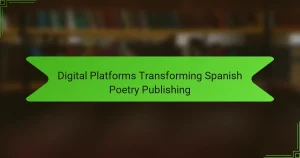Digital tools are revolutionising Spanish literary criticism by enhancing accessibility and fostering collaboration. Critics face challenges in adapting to new technologies and managing overwhelming digital content. Key platforms like digital archives and analytical software enable deeper analysis and broaden research opportunities. Social media facilitates real-time discourse, democratising literary criticism and encouraging diverse perspectives.
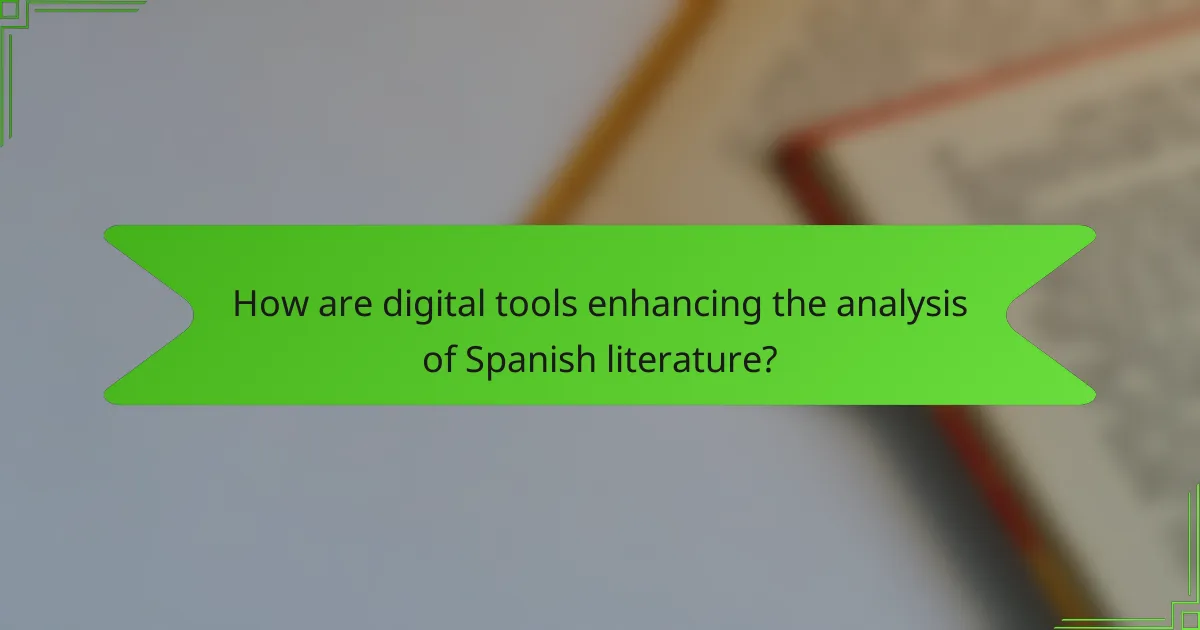
How are digital tools enhancing the analysis of Spanish literature?
Digital tools significantly enhance the analysis of Spanish literature by enabling deeper textual analysis and broader accessibility. These tools facilitate data mining, allowing scholars to uncover patterns and trends across vast literary works. For example, software like Voyant and AntConc helps in quantitative analysis, revealing word frequencies and thematic elements. Furthermore, digital archives provide access to rare texts, expanding research opportunities. As a result, the integration of these technologies transforms traditional literary criticism into a more dynamic and collaborative field.
What specific technologies are being utilized in literary criticism?
Digital tools significantly enhance Spanish literary criticism through various technologies. Text mining software analyses large volumes of literature, revealing patterns and themes. Digital archives provide access to historical texts, enriching contextual analysis. Social media platforms facilitate discussions, allowing critics to engage with wider audiences. Collaborative writing tools enable real-time feedback and revisions among scholars, fostering innovative critiques. Finally, visualisation software presents data in compelling formats, aiding in the interpretation of complex literary trends.
How does data visualisation impact literary analysis?
Data visualisation significantly enhances literary analysis by providing clear, engaging representations of textual data. It allows critics to identify patterns, themes, and trends in Spanish literature more effectively.
Visual tools facilitate the exploration of complex narratives, enabling scholars to analyse relationships between characters, plot structures, and thematic elements. For instance, network graphs can reveal character interactions, while timelines can illustrate narrative progression.
The integration of digital tools in Spanish literary criticism promotes interdisciplinary approaches, merging literary studies with data science. This fusion enriches the analytical process and fosters innovative interpretations of texts.
As a result, data visualisation transforms traditional literary analysis into a more dynamic and insightful practice, empowering critics to uncover deeper meanings within literary works.
Which digital platforms are most popular among Spanish literary critics?
Digital platforms popular among Spanish literary critics include social media sites, literary blogs, and online journals. Twitter and Instagram are widely used for real-time discussions and sharing reviews. Blogs provide in-depth analysis, while platforms like Medium allow critics to publish longer pieces. Online journals, such as “Revista de Letras,” offer a more formal outlet for critical essays. These tools foster community engagement and broaden access to literary discourse.
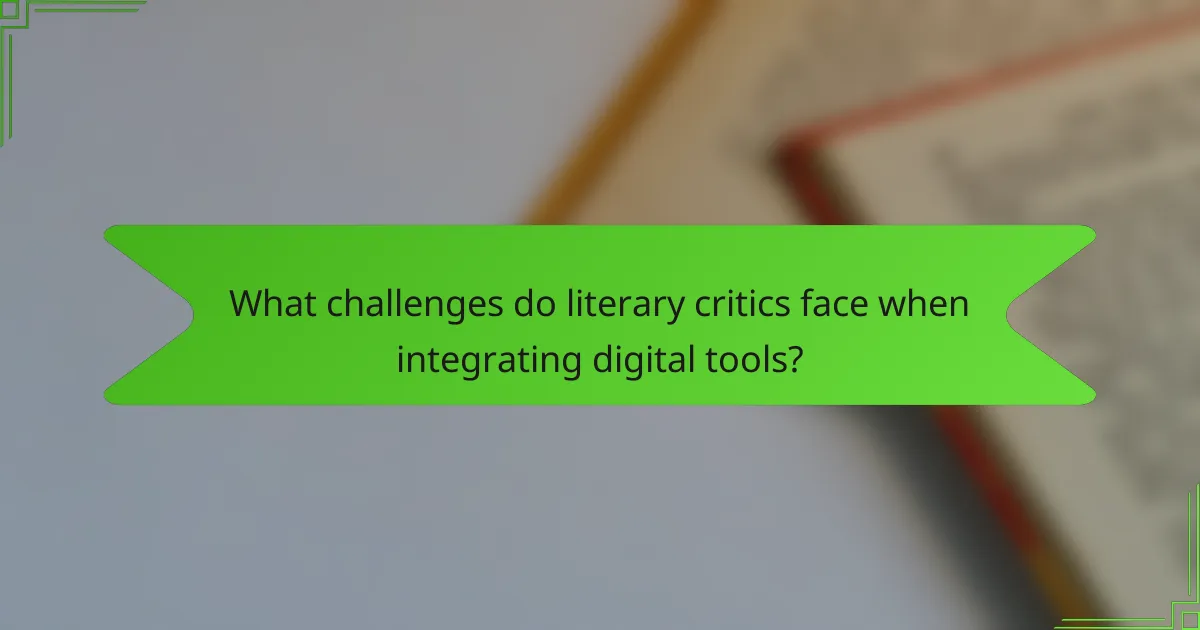
What challenges do literary critics face when integrating digital tools?
Literary critics face several challenges when integrating digital tools into Spanish literary criticism. These include adapting to new technologies, ensuring accessibility of digital resources, and maintaining critical rigor. Critics often struggle with the overwhelming volume of digital content, which can dilute focus on essential texts. Additionally, the rapid evolution of digital tools can create a knowledge gap, making it difficult for critics to stay current. Balancing traditional literary analysis with digital methodologies poses another significant challenge.
How do issues of accessibility affect the use of digital tools in criticism?
Accessibility issues significantly hinder the effective use of digital tools in Spanish literary criticism. Barriers such as inadequate software design, lack of training, and insufficient internet access limit participation and engagement. For instance, critics with disabilities may find it challenging to use platforms that are not optimised for screen readers. Moreover, language barriers can restrict access to critical resources, affecting the diversity of perspectives in the field. Addressing these accessibility issues is essential for fostering an inclusive environment that benefits all critics.
What are the common technical barriers encountered by critics?
Critics often face technical barriers such as limited access to digital resources, inadequate digital literacy, and challenges in data analysis. These obstacles hinder their ability to effectively engage with contemporary Spanish literature. Additionally, software compatibility issues and the fast-paced evolution of digital tools can complicate their critical work.
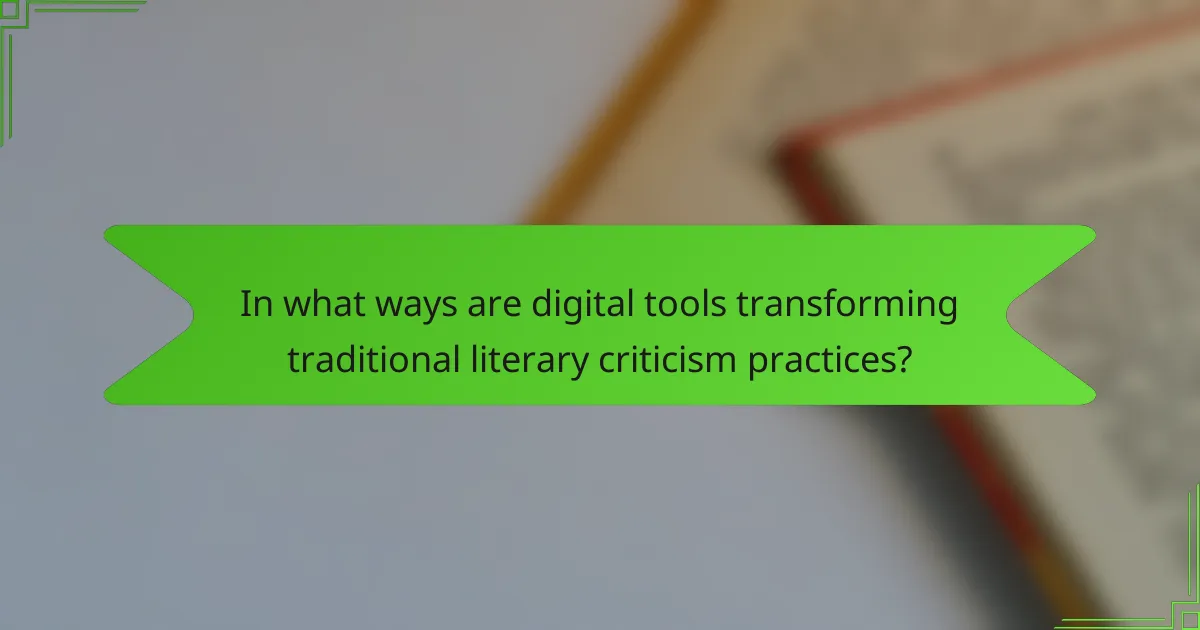
In what ways are digital tools transforming traditional literary criticism practices?
Digital tools are transforming Spanish literary criticism by enhancing accessibility, enabling collaborative analysis, and facilitating data-driven insights. These tools allow critics to engage with texts in innovative ways, such as through digital archives and analytical software.
For instance, platforms like digital humanities projects provide access to a wealth of primary sources, broadening the scope of research. Collaborative tools foster interaction among scholars, promoting diverse perspectives that enrich literary analysis. Data visualisation techniques enable critics to uncover patterns and trends in literature that were previously difficult to discern.
Moreover, social media platforms have created new avenues for discourse, allowing critics to share insights and engage with a wider audience. This democratisation of literary criticism encourages a more inclusive dialogue around Spanish literature. Overall, the integration of digital tools is reshaping the landscape of literary criticism, making it more dynamic and accessible.
How is online collaboration changing the landscape of literary criticism?
Online collaboration is transforming Spanish literary criticism by enhancing accessibility and fostering diverse perspectives. Digital tools enable critics to engage with a broader audience and share insights in real-time. Platforms like blogs and social media facilitate discussions that were previously limited to academic circles. This democratisation of literary critique encourages varied interpretations and enriches the overall discourse. As a result, traditional boundaries of criticism are expanding, allowing for a more inclusive dialogue around Spanish literature.
What role do social media platforms play in contemporary literary discussions?
Social media platforms significantly influence contemporary literary discussions by providing accessible spaces for dialogue and critique. They facilitate real-time engagement between authors, critics, and readers, fostering a dynamic exchange of ideas. For instance, platforms like Twitter and Instagram allow for concise commentary and visual storytelling, which can enhance literary analysis. Furthermore, the democratisation of voices on these platforms introduces diverse perspectives, enriching the discourse around Spanish literature. This shift reflects a unique attribute of digital tools: their ability to connect a global audience, transcending geographical and cultural barriers in literary critique.
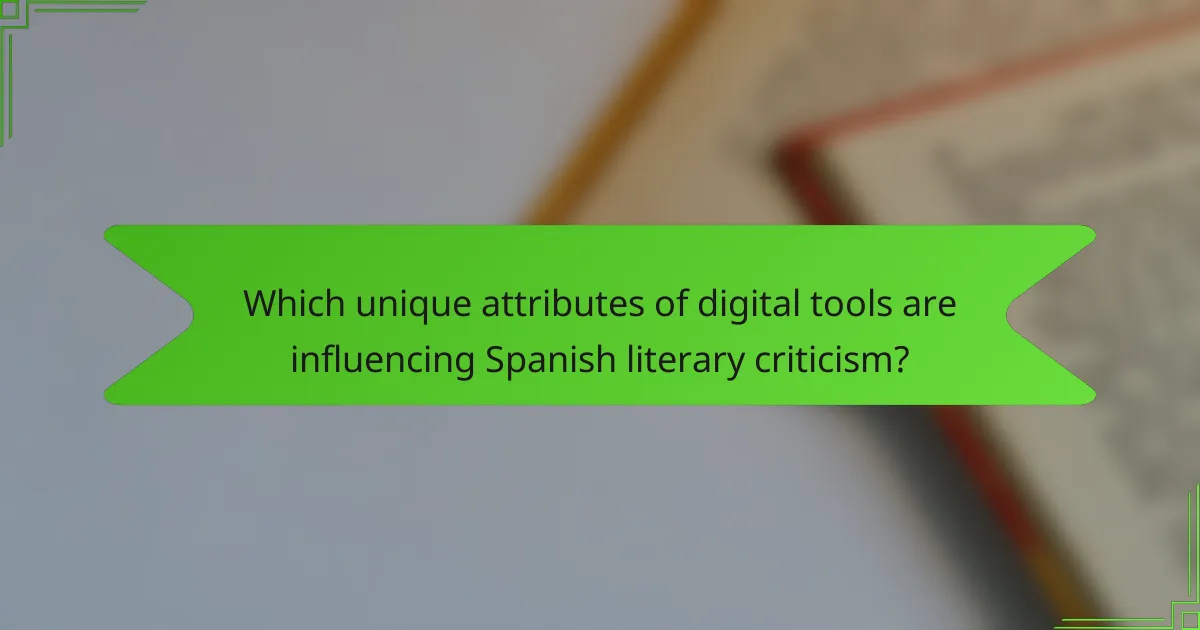
Which unique attributes of digital tools are influencing Spanish literary criticism?
Digital tools are uniquely influencing Spanish literary criticism by enhancing accessibility, fostering collaboration, and enabling data analysis. These tools allow critics to analyse texts through digital humanities methods, which reveal patterns and connections previously unnoticed. The integration of multimedia elements enriches criticism, offering new perspectives on traditional works. Additionally, platforms for peer review and discussion democratise the critique process, making it more inclusive.
How do algorithms affect literary interpretation and critique?
Algorithms significantly influence literary interpretation and critique by analysing patterns in texts. Digital tools enable critics to uncover themes, styles, and historical contexts that may not be immediately apparent. For instance, text mining allows for the exploration of large datasets, revealing trends across various literary works. This quantitative approach complements traditional qualitative analysis, enhancing the depth of critique. Additionally, algorithms can identify intertextual connections, enriching understanding of influences among authors. As a result, Spanish literary criticism is increasingly shaped by these technological advancements, providing fresh insights and expanding the scope of analysis.
What is the impact of digital archives on the preservation of Spanish literature?
Digital archives significantly enhance the preservation of Spanish literature by ensuring accessibility and longevity. These tools allow for the digitisation of rare texts, facilitating their preservation against physical decay. As a result, scholars can access a broader range of works, fostering diverse interpretations and critiques. Digital archives also support collaborative research, enabling scholars from various regions to contribute to the discourse on Spanish literature. The integration of metadata enhances searchability, making it easier to locate specific works or themes. Overall, digital tools are transforming the landscape of Spanish literary criticism through improved preservation and accessibility.
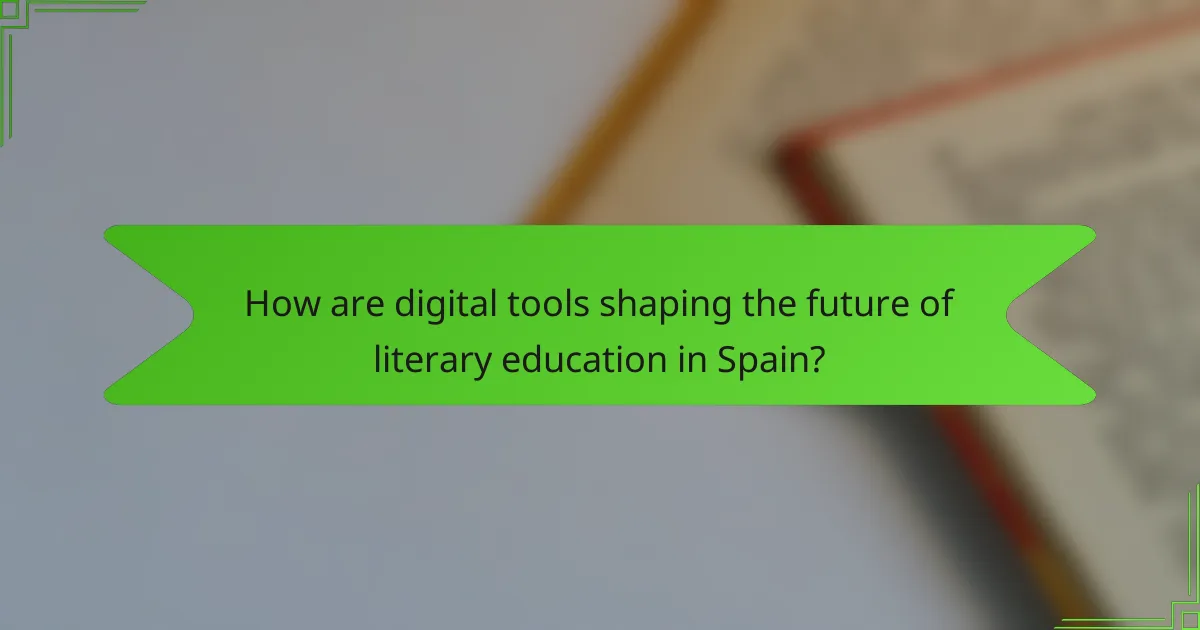
How are digital tools shaping the future of literary education in Spain?
Digital tools are significantly transforming Spanish literary criticism by enhancing accessibility and engagement. Online platforms enable broader participation in literary discussions, allowing critics and readers to share insights instantly.
Digital archives and databases provide access to a vast array of literary works, fostering deeper analysis and research. Tools like social media facilitate real-time conversations about literature, connecting diverse voices and perspectives.
Moreover, educational software and apps are integrating literary analysis into curricula, making it more interactive and appealing to students. This shift encourages critical thinking and creativity among learners, shaping the future of literary education in Spain.
What new methodologies are emerging in literary studies due to digital advancements?
Digital tools are revolutionising Spanish literary criticism by enabling new methodologies. These advancements include text mining, which uncovers patterns in large literary corpora, and digital archives that provide access to rare works. Collaborative platforms facilitate international scholarly communication, enhancing diverse perspectives. Additionally, social media allows for real-time discussions and critiques, broadening the reach of literary analysis. These methodologies reflect a shift towards data-driven and collaborative approaches in the field.
How are educators adapting to incorporate digital tools in literature courses?
Educators are integrating digital tools into literature courses by utilising multimedia resources and interactive platforms. These tools enhance student engagement and facilitate deeper analysis of texts. For example, online discussion forums allow for collaborative critiques, while digital annotation tools enable real-time commentary on literary works. Additionally, educators are adopting virtual reality experiences to immerse students in historical contexts of literature. This adaptation not only enriches the learning experience but also aligns with contemporary educational practices.
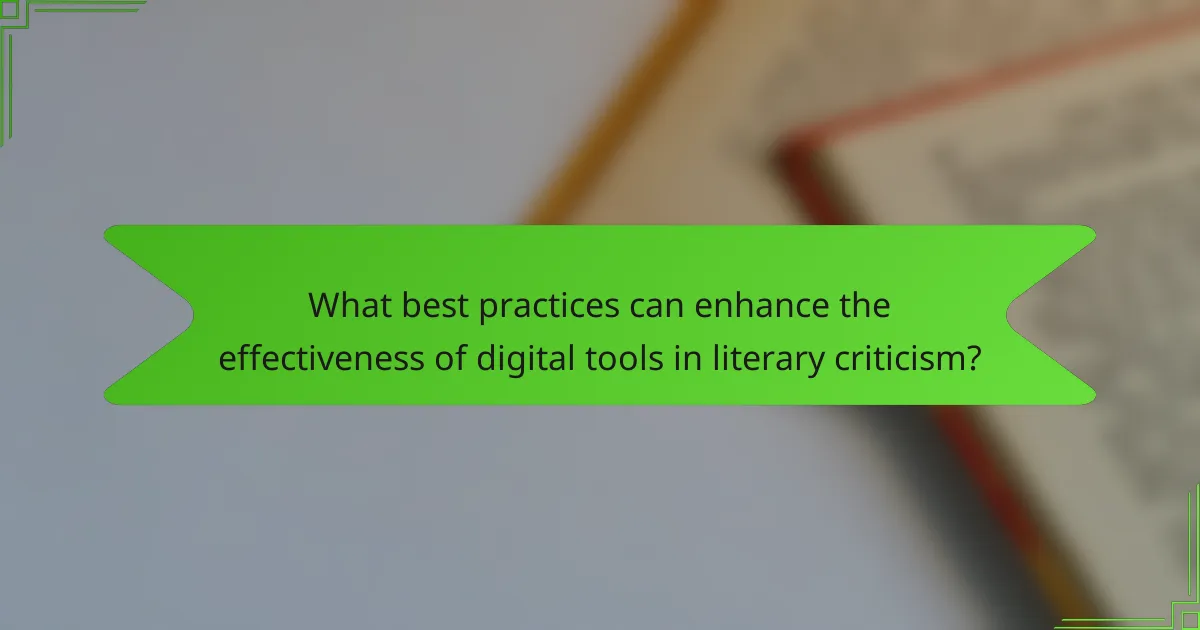
What best practices can enhance the effectiveness of digital tools in literary criticism?
Utilising best practices enhances the effectiveness of digital tools in Spanish literary criticism by fostering collaboration, improving accessibility, and leveraging data analytics. Collaborative platforms enable critics to share insights and engage in discussions, enriching the analysis. Accessibility features ensure a broader audience can engage with literary works, expanding critical discourse. Data analytics tools can identify trends and patterns in literature, providing critics with deeper insights into themes and styles. Emphasising these practices can lead to more informed and dynamic literary criticism.
What strategies can critics employ to maximise digital resource utilisation?
Critics can maximise digital resource utilisation by integrating diverse digital tools into their analysis. Utilising online databases enhances access to primary texts and scholarly articles. Social media platforms facilitate real-time discussions, expanding audience engagement and feedback. Data analytics tools can track literary trends, providing insights into reader preferences. Collaborative platforms enable shared critiques and peer feedback, enriching the critical discourse.
How can critics ensure the accuracy and credibility of digital sources?
Critics can ensure the accuracy and credibility of digital sources by employing rigorous evaluation methods. They should verify the author’s credentials, cross-check information with reputable sources, and assess the publication’s reputation.
Additionally, critics should analyse the source’s citations and references for reliability. Using digital tools like plagiarism checkers and fact-checking websites can further enhance the verification process. Engaging with peer reviews also helps in establishing credibility within the literary community.
